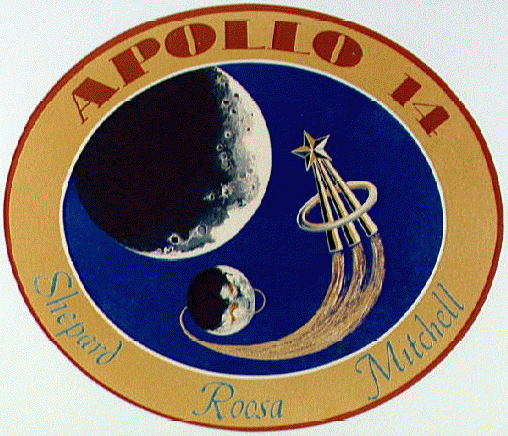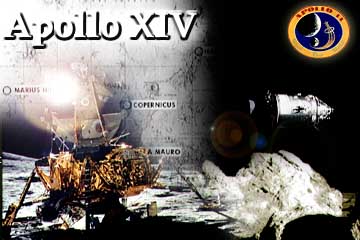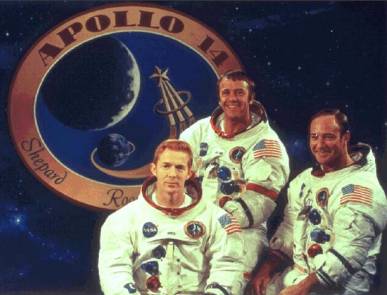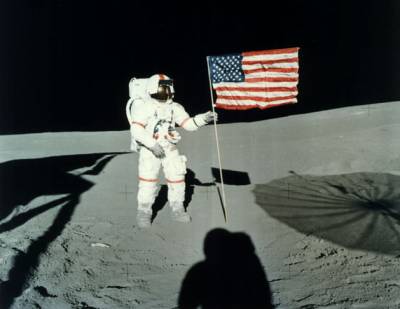
|
||||||||||||
|
|
|
Apollo 14
Launched: 31 January 1971 UT
21:03:02 (4:03:02 p.m. EST)
Alan B. Shepard, Jr., commander
Apollo 14 was the third mission in which humans walked on the lunar surface and returned to Earth. On 5 February 1971 two astronauts (Apollo 14 Commander Alan B. Shepard, Jr. and LM pilot Edgar D. Mitchell) landed near Fra Mauro crater on the Moon in the Lunar Module (LM) while the Command and Service Module (CSM) (with CM pilot Stuart A. Roosa) continued in lunar orbit. During their stay on the Moon, the astronauts set up scientific experiments, took photographs, and collected lunar samples. The LM took off from the Moon on 6 February and the astronauts returned to Earth on 9 February. Mission Profile After a delay of 40 minutes, 2 seconds due to clouds and rain, Apollo 14 was launched into Earth parking orbit on 31 January 1971 at 21:03:02 UT (4:03:02 p.m. EST) from pad 39A of Kennedy Space Center on Saturn V SA-509. Earth orbit insertion occurred at 21:14:51 UT followed by translunar injection at 23:37:34. An early first mid-course correction was made to make up for the launch delay so the spacecraft would arrive at the Moon on schedule. The CSM separated from the S-IVB stage containing the LM at 00:05:31 UT on 1 February. Five attempts were made to dock the CSM and the LM, all unsuccessful because the catches on the docking ring did not release. The sixth attempt, at 02:00:02 UT, was successful and no further problems with the docking mechanism occurred. The S-IVB stage was released into a lunar impact trajectory. (It impacted the lunar surface on 4 February at 07:40:55.4 UT at 8.09 S, 26.02 W with a velocity of 2.54 km/s at a 69 degree angle from the horizontal.) A second mid-course correction was made on 2 February and a third on 4 February. Lunar orbit insertion occurred at 06:59:43 UT on 4 February.
The LM, with Shepard and Mitchell aboard, separated from the CSM, piloted by Roosa, at 04:50:44 UT on 5 February and landed at 09:18:11 UT in the hilly upland region 24 km north of the rim of Fra Mauro crater at 3.6 S, 17.5 W. The astronauts made two moonwalk EVA's totaling 9 hours, 23 minutes, one on 5 February and one on 6 February, during which the Apollo lunar surface experiments package (ALSEP) was placed on the surface of the moon, 42.9 kg of lunar samples were acquired, and photographs were taken. At the end of the second EVA Shepard hit two golf balls. Experiments were also performed from the CSM in equatorial orbit. The LM lifted off from the Moon at 18:48:42 UT on 6 February after 33 hours, 31 minutes on the lunar surface. After the LM docked with the CSM at 20:35:53 UT the lunar samples and other equipment were transferred from the LM and the LM was jettisoned at 22:48:00 UT. It impacted the Moon on 8 February 00:45:25.7 UT at 3.42 S, 19.67 W. Transearth injection began at 01:39:04 UT on 7 February. One small mid-course correction was made on 8 February during transearth coast. The CM separated from the SM at 20:35:44 UT on 9 February. Apollo 14 splashed down in the Pacific Ocean on 9 February 1971 at 21:05:00 UT (4:05:00 p.m. EST) after a mission elapsed time of 216 hrs, 1 min, 58 secs. The splashdown point was 27 deg 1 min S, 172 deg 39 min W, 765 nautical miles south of American Samoa. The astronauts and capsule were picked up by the recovery ship USS New Orleans. This was the last Apollo mission in which the astronauts were put in quaratine after their return. Performance of the spacecraft, the third of the Apollo H-series missions, was good for most aspects of the mission. The primary mission goals of deployment of the ALSEP and other scientific experiments, collection of lunar samples, surface photography, and photography, radio science and other scientific experiments from orbit were achieved with the exception of the full coverage planned for the Hycon camera. Shepard, 47, was a Navy captain on his second spaceflight (he'd flown previously as the first American in space on Mercury Redstone 3), Roosa, 37, was an Air Force major on his first spaceflight, and Mitchell, 40, was a Navy commander also on his first spaceflight. The backup crew for this mission was Eugene Cernan, Ronald Evans, and Joe Engle. The Apollo 14 command module "Kitty Hawk" is currently on display at the Astronaut Hall of Fame in Titusville, Florida. Credit NASA |





